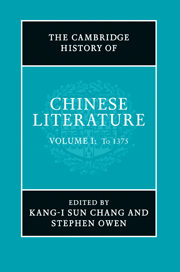Book contents
- Frontmatter
- Introduction
- 1 Early Chinese literature, beginnings through Western Han
- 2 From the Eastern Han through the Western Jin (ad 25–317)
- 3 From the Eastern Jin through the early Tang (317–649)
- 4 The cultural Tang (650–1020)
- 5 The Northern Song (1020–1126)
- 6 North and south: the twelfth and thirteenth centuries
- 7 Literature from the late Jin to the early Ming: ca 1230–ca 1375
- Select bibliography
- Glossary
- Index
- References
5 - The Northern Song (1020–1126)
Published online by Cambridge University Press: 28 May 2011
- Frontmatter
- Introduction
- 1 Early Chinese literature, beginnings through Western Han
- 2 From the Eastern Han through the Western Jin (ad 25–317)
- 3 From the Eastern Jin through the early Tang (317–649)
- 4 The cultural Tang (650–1020)
- 5 The Northern Song (1020–1126)
- 6 North and south: the twelfth and thirteenth centuries
- 7 Literature from the late Jin to the early Ming: ca 1230–ca 1375
- Select bibliography
- Glossary
- Index
- References
Summary
Overview
In certain ways the Song dynasty (960–1279) continued literary traditions already characteristic of the Tang. The literature that survives was produced by the educated elite, and it continued to be written in a book language, usually called literary Chinese, rather than in the vernacular. Writers were male, with only a few prominent exceptions. The forms of shi poetry and the many well-established genres of literary prose continued to dominate. It is only toward the dynasty’s end that we begin to see the emergence of drama and fiction written in the vernacular, and that only in very limited quantity.
Despite these continuities, distinctly new styles and modes of expression gradually emerged. A new style of poetry evolved and was established by the mid-eleventh century. It came to be so distinct from dominant Tang styles that already by the century’s end, and ever after, the two styles were often simplistically viewed as competing options. Critics were expected to express a preference for “Tang poetry” or “Song poetry” and would-be poets to model their work on one or the other. Another development was that the song lyric (ci) attracted increased attention and its scope became broader than the narrow compass it had had during the Five Dynasties. Eventually the song lyric became an important poetic alternative to shi poetry, with its own vocabulary, subjects, and expressive function. A whole range of prose writings appeared, including miscellanies, accounts of anomalies, a form of poetry criticism called “remarks on poetry,” connoisseur manuals on all manner of aesthetic objects, and travel diaries. Some of these were entirely new. Even those that were not were produced in such increased quantity that collectively they took on an identity quite unlike that of their precursors.
- Type
- Chapter
- Information
- The Cambridge History of Chinese Literature , pp. 381 - 464Publisher: Cambridge University PressPrint publication year: 2010
References
- 2
- Cited by

